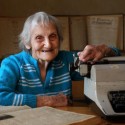
By NARELLE COULTER
VETERAN reporter Marg Stork dearly wanted to help celebrate the Journal’s 150th anniversary.
Sadly, she fell just short, passing last June aged 92.
Marg was diminutive in stature but she was lion-hearted when it came to her beloved Dandenong Journal.
Marg, as she was affectionately known, was the heart and soul of the Journal for more than 70 years.
She joined the newspaper in 1938 when she was just 15 and still a student at Dandenong High School, and never left. She was still filing her popular A Moment with Marg column just weeks before her death in June last year.
“People tell me things.”
Marg’s career spanned a world war, the Cold War, council amalgamations and huge social and technological change.
But through it all, Marg’s philosophy never changed: everyone had a story to tell and every story was important, no matter how big or small.
She was fond of saying that her professional longevity was due to her love of people.
“People tell me things,“ she said in an interview with her long-time editor John Woods in 2012.
“Like the taxi driver on the way here today told me about how he came from India, all about his children, his family.“
Marg resisted the technological revolution, shunning computers in favour of her trusty Olympia typewriter.
When computers first appeared in the Journal office, Marg tried working on one for a while, before reverting to her beloved typewriter.
It was the job of a junior reporter to take Marg’s typed stories and transfer them into the paper’s computer system.
No-one seemed to mind. Marg was a beloved figure, revered for her kindness, both in the office and in the wider community.
In the early days, surrounded by men, Marg instituted a swear jar.
The proceeds were donated to local charity Wallara.
Marg was never caught swearing but “used to put money in because it was such a good cause“.
Her work ethic was legendary.
Former colleague Phil McLeod remembers being daunted by Marg’s prodigiously long story lists when he first arrived at the Journal.
“At my first editorial meeting in (editor) John Wood’s office I was feeling pretty good about having four or five strong news stories,“ Phil recalled.
“Marg kicked off the meeting and proceeded to give details on about 20 stories from news, obituaries, to wedding anniversaries, sport, and human interest. Feeling a little embarrassed and somewhat inadequate, I did some creative accounting on my story count at the next meeting to at least match, or get anywhere near Marg’s tally.
“Things were looking promising when Marg admitted to having a pretty quiet week, but still had about 10 more yarns than the rest of us.
“I was caught out later when Woodsy asked me what my fictitious stories were about. In the end I realised I couldn’t possibly produce the amount of stories Marg did and that it was just a fact of Journal editorial life.“
Marg’s last visit to the Journal office, which by this time was located in Pakenham, occurred just months before she died.
Over morning tea, she spoke to young journalists just starting their careers with Star News Group, parent company of the Journal.
She spoke about the days when the Journal was written and printed on-site in Scott Street and when people would line up outside clutching threepence waiting for the newspaper to hit the street.
Marg spoke of working until 2am to ensure the paper was “put to bed“ and of collecting news on her bicycle, never missing a visit to Dandenong’s fire brigade, stopping for a chat with the police, and calling in on the school principals and church leaders.
She typed up countless wedding reports, announced the birth of hundreds of babies and farewelled prominent citizens with heart-felt obituaries.
Every story was important to Marg.
When he was a news editor deciding what would and wouldn’t make that week’s paper, Phil McLeod remembers Marg pulling up a seat beside him to ask when a particular story of hers would be running.
“She said she had promised that it would get a run, and that after a few weeks when it hadn’t, she felt she had broken her promise,“ Phil said.
“She prided herself on her honesty and integrity with the people she dealt with. Sometimes I just had to be firm and tell her I couldn’t run the story because of a lack of space, and that there were more important stories. But to her every story was important, and so were the people they were about.
“I had to be tough with her at times, but then she would give me this look. I’d feel guilty about being so grumpy and short with her and the next thing I know I’m telling her to ring the person concerned to tell them we would be running the story this week. She could play me like a fiddle at times.“
The schoolgirl whose dad bought her first typewriter at Dandenong Market when she was 10 became the epitome of a great community journalist, whose body of work is unlikely to be surpassed.
Marg had a signature closing line in telephone interviews.
Someone might have won an award, or reached a milestone in their lives and after getting the full story she would sign off with: “I wish you all the luck in the world“.
And she meant every word of it.









